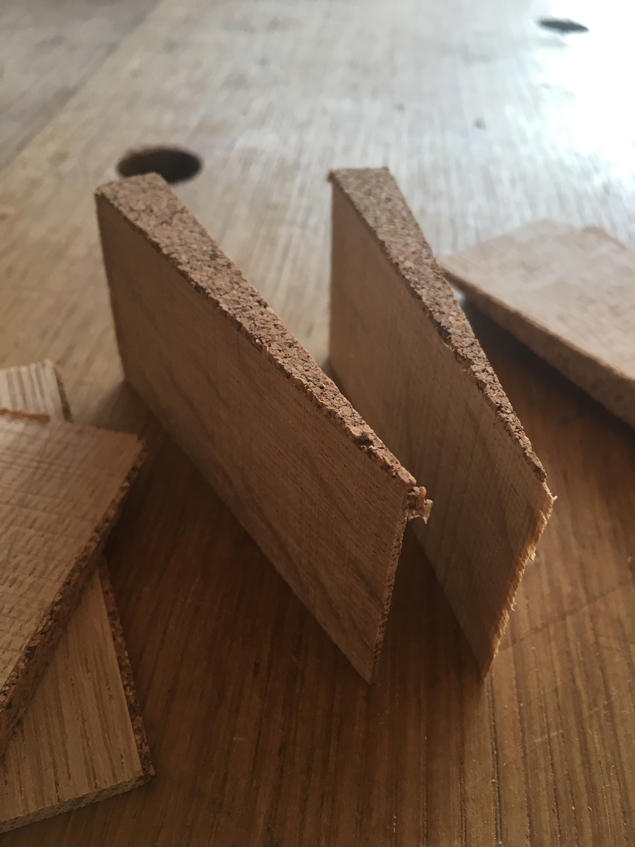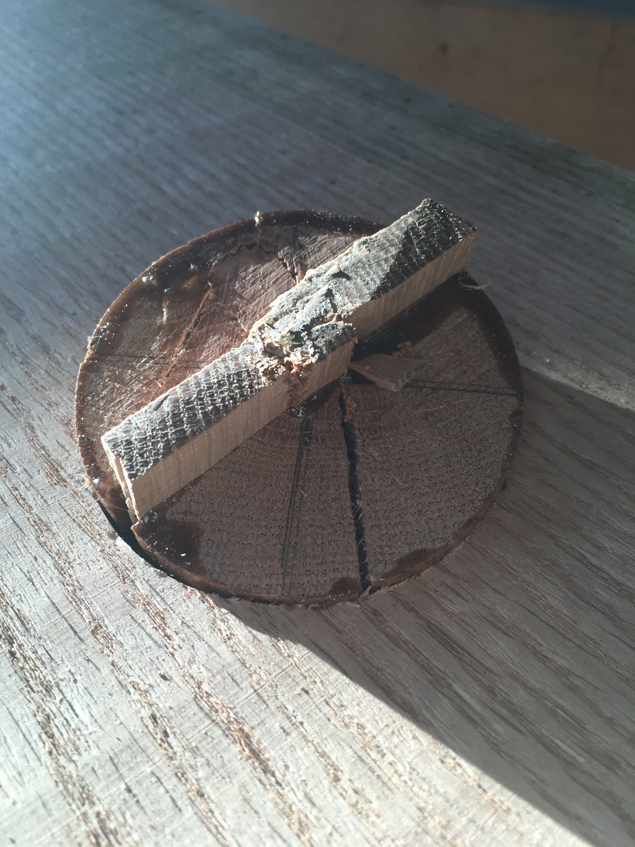We may receive a commission when you use our affiliate links. However, this does not impact our recommendations.
There are so many old wives’ tales in our craft that you could write an entire book that lists and debunks them. Students constantly bombard me with them, and it makes me wonder: How do these begin?
After a slip of the tongue the other day, I think I have a good idea.
This week I’m assembling a Roman workbench and had a couple woodworking friends over as we drove in the 3” tenons into the benchtop and wedged them in place. The wedges were massive slips of oak that I’d cut earlier in the day.
The weird thing about my wedges was that they each had a thin layer of cork affixed to one edge.
“What’s the cork for?” one guy asked.
“Because the top is so wet and these tenons are so big, the springy cork will allow for some wood movement without the wedges splitting the benchtop,” I replied.
I was, of course, joking. The cork was there because it had been stuck to the piece of scrap I’d grabbed to make the wedges. But the response from the other woodworkers was heads nodding.
Oh crap, I thought. So I quickly admitted that I was joking. The information was false. But my bullcrap had sounded good, and that was the problem.
Lots of times, students ask me “why” I am doing a certain operation. If I know the answer I tell them. But if I don’t know, I am quick to say: “I don’t know.” But I know a lot of people who won’t say “I don’t know,” and so they’ll generate a logical but false response. Here’s an example that I’ve heard first-hand many times:
Question: Why do you finish both sides of a tabletop?
Answer: To equalize the moisture exchange on both faces of the board to prevent the board from warping.
The answer sounds reasonable, but it’s completely the opposite of fact. And so the information is absorbed by the student and passed on. And because the information sounds logical, it’s almost impossible to stamp out the falsehood, especially once it’s written down.
So if you know nothing, say nothing.
— Christopher Schwarz
Here are some supplies and tools we find essential in our everyday work around the shop. We may receive a commission from sales referred by our links; however, we have carefully selected these products for their usefulness and quality.











So much for spending the time and money finished interiors that never see the light of day. What about veneering both sides of your substrate – same as other “wives tales”, or is this one fact??
Experts are necessary my favorites are people like Chris here. They pass on there experience with out extra fluff. I appreciate comments like “my experience because it informs me that you have actually seen it. At least until you lie. Can’t wait till I get another of your books.
I happened to read this blog post before I was headed out to visit some local antique malls. Coincidentally, I came across the book “Wood Construction: Principles-Practice-Details” (A project of the National Committee on Wood Utilization United States Department of Commerce) by Dudley F. Holtman et al. published 1929
Wouldn’t you know this book also perpetrates the myth: “Uneven coatings on wood cause warping”
Here’s a pic I snapped of the relevant pages: http://imgur.com/a/UObSU
I guess this myth goes back a long long time.
I spent the ’90s (give or take) hanging out in an online group devoted to urban legends, mostly picking them apart and debunking them. I was amazed at how many things that turned up as actual beliefs were things I’d heard as jokes 10-15 years before.
I always thought that miraculous multiplication was a myth, but apparently my dad got a piece of the True Cross in his shop, and it multiplied into a million scraps of wood all over the place. Then I accidentally got one into my stuff, and the same thing happened to my garage. Good thing I know a scout troop that needs a lot of wood scraps…
OMGoodness. LMButtO. Brilliant opine, call & responses. Perfect Saturday morning reading. Dang I miss papers.
With all respect to Bob Flexner, and to you, debunking a myth by citing an expert opinion is not my idea of an evidence based argument. You may be right or wrong regarding the need to seal both sides of furniture wood, but I need to see more evidence if I am to be convinced one way or the other. I have a suspicion, again based on no evidence (I just offer it as a possibility) that many traditional notions about moisture and wood movement arose in a time when dwellings were poorly protected against outdoor moisture and temperature change. Perhaps, in modern climate controlled buildings, some of the old measures, myths if you will, to ensure wood stability, are no longer relevant (?)
Truth or myth? Detensioning a bandsaw blade. You said in 2012 it was good for the saw and the blade. The more I have read that seems more myth than truth. Do you still detension your bandsaw?
My favorite “expert” daffynition is: “Someone with a briefcase who is far from home.” Met a lot of them in my Air Force career *<{;o)
…
Ask an expert “Why?” Definition of expert: “Ex” is a “has been”. “Spurt” is a “drip under pressure”. Way too many experts just repeat what the other person they considered an expert said. To find the truth, do it yourself. Then, you too, can be an expert! That’s why I have more respect for people like Chris who tries it rather than just believing it so.